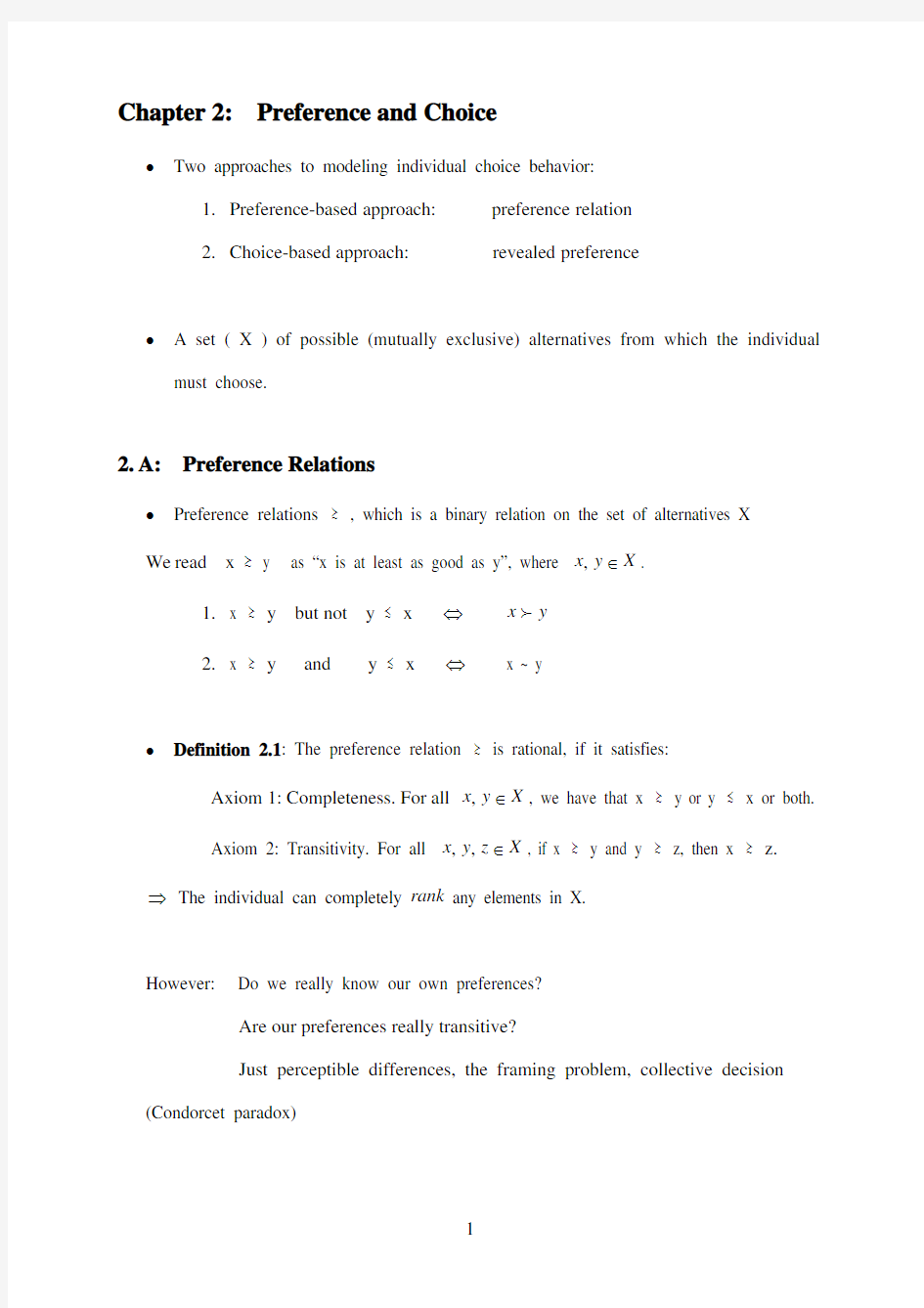Chapter 2Preference and Choice(高级微观经济学-上海财经大学,沈凌)

- 1、下载文档前请自行甄别文档内容的完整性,平台不提供额外的编辑、内容补充、找答案等附加服务。
- 2、"仅部分预览"的文档,不可在线预览部分如存在完整性等问题,可反馈申请退款(可完整预览的文档不适用该条件!)。
- 3、如文档侵犯您的权益,请联系客服反馈,我们会尽快为您处理(人工客服工作时间:9:00-18:30)。
Chapter 2: Preference and Choice
• Two approaches to modeling individual choice behavior:
1. Preference-based approach: preference relation
2. Choice-based approach: revealed preference
• A set ( X ) of possible (mutually exclusive) alternatives from which the individual must choose.
2. A: Preference Relations
• Preference relations ≿ , which is a binary relation on the set of alternatives X We read x ≿ y as “x is at least as good as y”, where X y x ∈,.
1. x ≿ y but
not y ≾ x ⇔ y x f 2. x ≿ y and y ≾ x ⇔ x ~ y
• Definition 2.1: The preference relation ≿ is rational, if it satisfies:
Axiom 1: Completeness. For all X y x ∈,, we have that x ≿ y or y ≾ x or both. Axiom 2: Transitivity. For all X z y x ∈,,, if x ≿ y and y ≿ z, then x ≿ z. ⇒ The individual can completely rank any elements in X.
However: Do we really know our own preferences?
Are our preferences really transitive?
Just perceptible differences, the framing problem, collective decision (Condorcet paradox)
2. B: Choice Rules
• A choice structure (B , C(•)), where B is a family of nonempty subsets of X, C(•) is a choice rule.
• The weak axiom of revealed preference : if for some B ∈B with B y x ∈, we have )(B C x ∈, then for any ∈'B B with ',B y x ∈ and )'(B C y ∈, we must also have )'(B C x ∈.
Example: {}z y x X ,,=, and B {}{}{}z y x y x ,,,,=
{}(){}{}(){}x z y x C x y x C C ==,,,,:111 yes {}(){}{}(){}y x z y x C x y x C C ,,,,,:222== no
2. C: The relationship between preference relations and choice rules
• Definition 2.2: Given a choice structure, the revealed preference relation ≿* is defined by: x ≿* y ⇔ there is some B ∈B such that B y x ∈, and )(B C x ∈. ? Does the revealed preference satisfy Axiom 1 & 2 ?
• Definition 2.3: Given a rational preference, the generated choice structure is (B , C*(•, ≿)) such that C*(B, ≿) ={x ∈B: x ≿ y for every y ∈B}.
• Theorem 2.4: Suppose that ≿ is a rational preference relation. Then the choice structure generated by ≿, (B , C*(•, ≿)), satisfies the weak axiom.
Proof: Suppose that for some B ∈B we have B y x ∈, and ∈x C*(B, ≿). By the definition of C*(B, ≿), this implies x ≿ y .
Suppose that for some B’∈B with ',B y x ∈ we have ∈y C*(B’, ≿). This implies that y ≿ z for all 'B z ∈. Hence, according to transitivity axiom, we have x ≿ z. We can conclude that ∈x C*(B’, ≿). It is precisely the conclusion that the weak axiom demands.
• Theorem 2.5: If (B , C(•)) is a choice structure such that: (1) the weak axiom is satisfied, (2) B includes all subsets of X of up to three elements, then there is one and only one rational preference ≿ such that C(B)=C*(B, ≿) for all B ∈B .
Proof :it is natural to think that the revealed preference is the candidate. Now we need to proof: i) ≿* is rational. ii) C(B)=C*(B, ≿*). iii) ≿* is the unique preference relation.
i) Completeness: By assumption (2) {}∈y x , B . Thus, either x or y must be an element of C({}y x ,), we must have x ≿* y , or y ≿* x , or both. Hence, it is complete. Transitivity: let x ≿* y and y ≿* z. We need to show x ≿* z. Consider {}∈z y x ,,B . If {}()z y x C x ,,∈, then x ≿* z. If {}()z y x C y ,,∈, then {}()z y x C x ,,∈ by the first assumption, i.e., the weak axiom is satisfied. Suppose {}()z y x C z ,,∈, since y ≿* z, the weak axiom yields firstly {}()z y x C y ,,∈, and then {}()z y x C x ,,∈.
